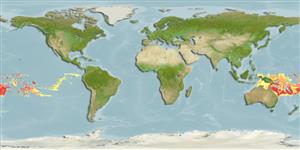Environment: milieu / climate zone / depth range / distribution range
Ecologia
marinhas; Água doce; estuarina demersal; catádromo (Ref. 51243); intervalo de profundidade 0 - 3000 m (Ref. 86942). Tropical; 2°N - 27°S
Pacific Ocean: western New Guinea and Queensland, Australia to the Society Islands. A single specimen was recorded from a tributary of the Buffalo River, near King William's Town in South Africa (Ref. 3506), but this is questionable.
Tamanho / Peso / Idade
Maturity: Lm ? range ? - ? cm
Max length : 110 cm TL macho/indeterminado; (Ref. 5259); common length : 60.0 cm TL macho/indeterminado; (Ref. 5259)
Vértebras: 102 - 108. Belongs to the group of anguillas which have a short dorsal fin which originates slightly before the anus (Ref. 48622). Most closely resembles Anguilla australis and A. bicolor, from which it can be distinguished with certainty only by the number of vertebrae. Also Ref. 2847.
Inhabits freshwater streams, lakes and swamps, favouring coastal lagoons and the lower reaches of rivers. Spawning adults occur in marine waters. Sub-adults spend most of their lives in fresh or brackish waters (Ref. 44894). Found in large turbid rivers and small creeks (Ref. 2847). Occurs both in running and stagnant waters (Ref. 12790). Feeds mainly on fishes, crustaceans and mollusks.
Ciclo de vida ou comportamento de acasalamento
Maturities | Reprodução | Spawnings | Egg(s) | Fecundities | Larvas
Allen, G.R., 1989. Freshwater fishes of Australia. T.F.H. Publications, Inc., Neptune City, New Jersey. (Ref. 5259)
Status na Lista Vermelha da UICN (Ref. 130435)
Ameaça para os humanos
Harmless
Uso pelos humanos
Pescarias: pesca de subsistência
Ferramentas
Relatórios especiais
Baixar XML
Fontes da internet
Estimates based on models
Preferred temperature (Ref.
123201): 3.6 - 10.2, mean 4.8 °C (based on 263 cells).
Índice de diversidade filogenética (Ref.
82804): PD
50 = 0.5000 [Uniqueness, from 0.5 = low to 2.0 = high].
Bayesian length-weight: a=0.00050 (0.00030 - 0.00083), b=3.15 (3.01 - 3.29), in cm total length, based on LWR estimates for this species & Genus-body shape (Ref.
93245).
Nível Trófico (Ref.
69278): 4.5 ±0.80 se; based on food items.
Resiliência (Ref.
120179): Muito baixo(a), tempo mínimo de duplicação da população maior que 14 anos (Preliminary K or Fecundity.).
Fishing Vulnerability (Ref.
59153): High to very high vulnerability (66 of 100).
